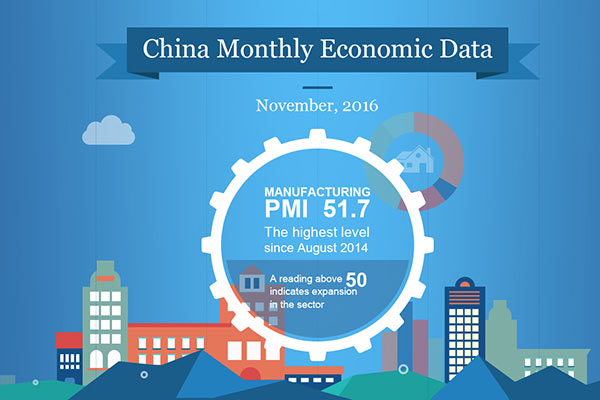Chinese economy ends 2016 on 'positive note'
BEIJING - The Chinese economy ended on a positive note in 2016, with both the manufacturing and service sectors registering strong increases in business activities in the final month of the year, a private survey showed Thursday.
China's service sector continued to expand in December, posting its strongest rate in 17 months, according to the survey conducted by financial information service provider Markit, sponsored by Caixin Media.
The Caixin General Services Purchasing Managers' Index (PMI) edged up to 53.4 from 53.1 in November. The previous high was 53.8 in July 2015.
A reading above 50 indicates expansion, while below 50 represents contraction.
Demand in the sector picked up as new orders at service companies rose in December at the fastest pace in 17 months.
Rising raw material costs for service companies caused expenses to soar at their quickest rate in nearly two years, but service providers only slightly raised their prices in December due to market competition.
Optimism about growth prospects in 2017 reached a four-month high, with surveyed companies generally showing more confidence due to improving market conditions and company expansion.
The Caixin China Manufacturing PMI, released Tuesday, hit a 47-month high of 51.9 in December.
The strong performance in the two sectors meant the Caixin Composite Output Index, which reflects performance in both sectors, hit a 45-month high of 53.5 in December from November's 52.9.
Zhong Zhengsheng, director of macroeconomic analysis at CEBM Group, an investment research firm, said the figures showed continued recovery in China's economy.
"The Chinese economy performed better in the fourth quarter than in the previous three quarters. It is without question that the government full year growth target will be reached," Zhong said.
China's GDP grew 6.7 percent in the first three quarters of 2016, within the government target of between 6.5 and 7 percent for the year.
GDP growth in the fourth quarter of 2016 is expected to stay flat at 6.7 percent year on year, partly due to stronger fixed asset investment and retail sales in December, according to China International Capital Corporation.
National Bureau of Statistics data showed that China's manufacturing and non-manufacturing PMI posted the second-highest monthly reading of 2016 in December, adding to signs of economic stabilization.
Chen Zhongtao, analyst at the China Logistics Information Center, said positive factors have grown for the Chinese economy, including increasing demand, rising prices, better performance for companies, restructuring and a good job market.
However, Zhong also warned that China should stay alert about downward pressures on the economy, with gradually tightening property policies and likely tightening of fiscal and monetary policies.
China is facing a complicated situation both at home and abroad, including weak growth momentum in major economies, rising trade protectionism, domestic debt overhang, excess capacity and a highly leveraged property market.
China has made "seeking progress while maintaining stability" the main theme for economic work in 2017, pledging to push for substantial progress in supply-side structural reform, according to the Central Economic Work Conference.
Central bank advisor Huang Yiping said the government should set a more flexible target for economic growth in 2017 to make more room for reforms, proposing a GDP growth target range of 6-7 percent for 2017.
- Chinese economy faces opportunities, challenges: Economists
- Expectations for Chinese economy improve: German institute
- Stable Chinese economy drives strong consumer confidence
- Premier Li: Chinese economy to keep steady growth and speed up transformation
- Chinese economy stabilizing in difficult balancing act

















